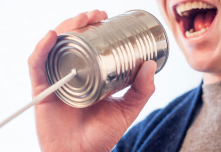
By Al Bredenberg, Senior Writer
In spite of the growth of digital channels, phone-based interaction remains a crucial part of the automobile sales process. But as previously reported by Cantin Automotive Insider, car dealerships’ call handling practices leave much room for improvement.
A study by Cox Automotive found that phone calls make up 26 percent of customers’ initial contacts with auto dealers. Yet, IHS Automotive reported that 84 percent of inbound sales calls are not converted to sales.
Businesses that neglect phone interaction are leaving money on the table. Forrester Research found recently that phone-based leads out-pull other sources. In a survey conducted by the firm, marketers reported that customers who initiate a phone call convert 30 percent faster, spend 28 percent more, and show a 28 percent higher retention rate. Nowadays, a customer journey can become complex, consisting of multiple touchpoints during the sales process. However, Forrester’s respondents disclosed that “customers who initiate an inbound call at some point in the customer journey comprise an average of 27 percent of their overall sales.”
Outbound sales calling plays a vital role in that phone-based communication process. However, indications are that dealerships are not paying attention to this part of the sales process. Brian Pasch, CEO of PCG Research reported that, in a study of over six million outbound sales calls from auto dealerships, “an amazing 86 percent never connected with the customer.”
Are Phone Contacts Your “Blind Spot”?
These days, automotive marketers are managing a broad array of lead sources — email, search, inbound and outbound calls, mobile leads, online chats, social media, display and print ads, TV, and direct mail. Do phone calls deserve special priority in the mix?
The Marchex Institute analyzed some eight million calls received by 16 auto brands in the first half of 2017. Marchex noted that “marketers are devoting ever more of their budgets to servicing digital channels, driven by demand from customers who continue to adopt new technologies, consume more digital content, and transact more online.” However, the authors of the study fear that this focus on digital channels is resulting in a “blind spot” on the part of automotive retailers when it comes to phone contacts.
The reality is that the use of digital channels has got the phones ringing at dealerships more than ever. On a mobile website with a click-to-call link, a customer can reach a dealer quickly, without having to fill out a laborious online form.
Brent Rogers, now vice president at Green Line Digital, served recently as chief marketing officer (CMO) at Patrick Dealer Group, a Chicago-area automotive retailer, where he ran a successful business development center (BDC). Rogers told Cantin Automotive Insider that phone calls are now outstripping email leads in auto retailing, all because of mobile commerce.
“Traffic on the internet is going more and more mobile. Everybody’s watching TV with a mobile device in their hand simultaneously, and the patience of those mobile customers is very slim,” he said. “You used to see a nice increase in the number of email leads, but now phone calls are increasing as a percentage of overall leads. People tend not have the patience for online forms, and they’re reluctant to fill out a form and then get spammed. Everything has transitioned to that impatient person watching TV making a phone call to you. That’s your real opportunity.”

And the opportunity is considerable. NADA’s latest analysis finds that the average gross profit for a new car sold in the U.S. is $2,014. A few more showroom appointments every day could rake in an additional five or six figures a month.
Rogers stressed that converting today’s vehicle customer requires a new approach to sales, especially when comes to transparency. “The consumer mindset has changed with the Internet,” he said, “and how you have to treat the customer has changed.”
As an example, he pointed out that customers now often call from longer distances looking for the car they want at the right price.
“If they’re coming from two hours away, you might have to be more transparent on the phone,” he said. “Few customers will travel such a distance without knowing what the deal is. The old way was not to give any information away, and just try to set the appointment. I’m not saying you have to give away the price right away. It’s still a negotiation world, and people are going to pay different prices. But you need to get to know the customer and when to give out information.”
Keep in mind that text messaging or SMS is a key component of phone communication today and needs to be included in the call-handling workflow. Commenting on a study his company conducted of one call management system, Pasch from PCG Research wrote: “It was surprising to learn just how many shoppers were texting back to respond, ‘I am in a meeting,’ or ‘Call me at my home number later today.’ Texting is what the general public does every day.”
To BDC, or Not to BDC?
While the BDC is Rogers’s preferred model for call handling, he acknowledged that this is not the best option for every business. “Some stores make it work with no BDC,” he told us. “It’s just a lot of management, but you can make it work.”
The BDC model will continue to spread, said Mark Vickery, senior director of performance management at Cox Automotive’s VinSolutionsdivision, speaking with Cantin Automotive Insider. However, he, too, emphasized that the BDC is not the ideal solution for every dealership. “That requires a physical investment that not all dealers are able or prepared to make,” he said.
For many businesses, that might mean showroom sales staff will be the ones making outbound calls, especially for established customers or for prospects at various stages of the customer journey. “The important thing is that, no matter who’s handling the call, you’d better have processes in place to help customers make decisions,” Vickery said.
Rogers said that poor results in phone operations aren’t necessarily the fault of frontline staff. Old-style sales managers often want to play their cards close to the chest, Rogers said: “I think it’s a management problem, more so than the people on the phone. The sales manager says ‘don’t give out any information until the customer gets here.’ I can’t understand the leverage dealers think they have, when the next dealer is just a keystroke away.”
Still Crucial: Ask for the Appointment
All the same, don’t underestimate the value of simply asking for an appointment. Marchex’s study found that sales-related calls to the top 16 car brands resulted in only a 12 percent appointment rate, so there’s certainly room for improvement. Make that a step in the formal process. Some shoppers are ready now, and will come in just because you asked them to.
“The one thing that’s no different now than before,” said Vickery, “is that the whole purpose of the phone call is to get them to be willing to come in. It’s just that we have to provide more information than we used to, to earn the opportunity for them to come in. Our mission has to be to help them with what they need, to give them the answers to their questions, to help them get to a place where they’re comfortable coming in and buying a car.”
Rogers agreed about the centrality of showroom appointments. In the BDC he ran for Patrick Dealer Group, his team paid close attention to appointment-setting as a performance metric for contact reps.
“We decided to have dedicated people setting appointments in a set way, “he said. “Pay-for-performance is key in any commission role, of course. But in this case, we paid bonuses based on percentage objectives, as opposed to just the number of sales. So, if they set appointments at a 60 percent level, for example, there was a little kicker for that. We paid top performers on key metrics a little more as well — not crazy money, but enough to add some competition.”
Outbound calling was also included as a performance metric. “If they didn’t manage a certain number of outbounds, they were ineligible to receive the other bonuses,” Rogers said. “It’s easy to give up or get lazy and not make the call. This gave them an incentive to hit the phones and call clients. That way, you’re still incentivized to make the extra call, even if it takes you seven or eight or nine times before you set the appointment.”
When making outbound sales calls, voicemail systems present an obstacle for many sales people, according to VinSolutions’ Mark Vickery. He called our attention to an often-neglected skill: how to leave a voicemail message.
“When you make calls these days,” he said, “you are going to get voicemail most of them time, if not every time. Sales people tend to get worn out with the volume of calls. It gets a little mundane. What you have to do is go back to ‘Phone Skills 101.’ Every phone call needs to sound like your first call of the day, like you’re pumped up and interested in the customer. You might be able to put into play something specific about the customer: ‘Hey, Al, this is Mark trying to reach you about the Camry you wanted. I’ve got great news for you!’”
The customer just might call back with great news for you.












